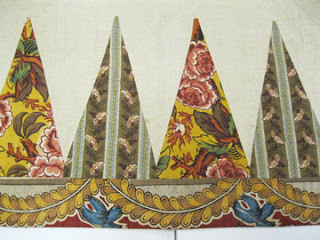I've published a little book at Blurb.com called Lately Arrived From London: Cotton Prints & Patchwork Before 1820. It's a companion to my Moda fabric collection called Lately Arrived From London that will be in shops in September 2011.
Here are page spreads from the book
It's difficult to coordinate any kind of print material with a reproduction fabric line as they have such different lead times. But this Print-On-Demand book is available now and cannot be sold out. You can buy it now or buy it later when the fabric arrives in shops. Or when you finish the quilt made from the line.
It's 40 small pages (7" square), full of period illustrations and pictures of the fabric.
The fabric collection recreates prints from the turn of the 19th century when Americans imported their cottons. Traders brought the world’s luxury goods to wharves in Philadelphia, Boston and New York. Each piece is named for a trading ship that sailed into American harbors---the Charming Betsy, the Brigantine Sally, the Ship Surprise.
See more about the fabric by clicking here to see a PDF
In the book I focused on Philadelphia's shops, particularly Chestnut Street, pictured here in the 1840s.
I wrote about the technology and taste that produced the prints. Here's a printed stripe that looks like a warp-printed woven pattern.
I show the original document print (above) and the reproductions
I include a few patterns for period quilts.
And some medallion quilts by my friends for inspiration.
I see it as a gift book, perfect to package with precut JellyRolls or Layer Cakes---or a little quilt made from the fabric.
You order it from Blurb.com. Click here to see a preview of the book:
You can order it as a paperback or a hardback book. Because it's print-on-demand they do not offer a wholesale price, but they do offer a quantity discount.
The great thing about these Blurb books is there is so little turn-around time. I can do one in a week and have it in my hands the next week. PLUS---no book storage for me.
The great thing about these Blurb books is there is so little turn-around time. I can do one in a week and have it in my hands the next week. PLUS---no book storage for me.




















































